Founding Fathers of the United States
Founding Fathers of the United States


Signature page of the Treaty of Paris of 1783 that was negotiated on behalf of the United States by John Adams, Benjamin Franklin and John Jay
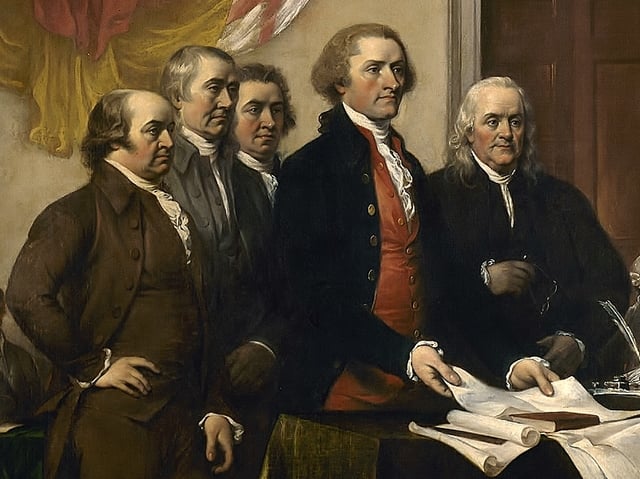
A Committee of Five, composed of John Adams, Thomas Jefferson, Benjamin Franklin, Roger Sherman, and Robert Livingston, drafted and presented to the Continental Congress what became known as the U.S. Declaration of Independence of July 4, 1776.
The Founding Fathers of the United States, or simply the Founding Fathers, were a group of American leaders who united the Thirteen Colonies, led the war for independence from Great Britain, and built a frame of government for the new United States of America upon republican principles during the latter decades of the 18th century. Most Founding Fathers at one point considered themselves British subjects, but they came to understand themselves more as patriotic Americans who possessed a spirit distinct from that of their motherland. The group was composed of businessmen, lawyers, philosophers, politicians, plantation owners and writers from a variety of social, economic, and ethnic backgrounds. The Founding Fathers came from a variety of occupations, and many (such as, John Adams, a lawyer; Charles Carroll of Carrollton, a planter; and Benjamin Rush, a doctor) had no prior political experience.
Historian Richard B. Morris in 1973 identified the following seven figures as key Founding Fathers: John Adams, Benjamin Franklin, Alexander Hamilton, John Jay, Thomas Jefferson, James Madison, and George Washington.[4][5] Jefferson, Madison, and Washington were slave owners. Franklin, Hamilton and Jay were leading opponents of slavery. Adams, Jefferson, and Franklin were members of the Committee of Five that drafted the Declaration of Independence. Hamilton, Madison, and Jay were authors of The Federalist Papers, advocating ratification of the Constitution. The constitutions drafted by Jay and Adams for their respective states of New York (1777) and Massachusetts (1780) were heavily relied upon when creating language for the U.S. Constitution.[6] Jay, Adams, and Franklin negotiated the Treaty of Paris (1783) that would end the American Revolutionary War.[7] Washington was commander-in-chief of the Continental Army and was president of the Constitutional Convention. All held additional important roles in the early government of the United States, with Washington, Adams, Jefferson, and Madison serving as president. Jay was the nation's first chief justice, Hamilton was the first secretary of the treasury, and Franklin was America's most senior diplomat, and later the governmental leader of Pennsylvania.
The term Founding Fathers is sometimes used to refer to the Signers of the embossed version of the Declaration of Independence in 1776.[8] Signers is not to be confused with the term Framers; the Framers are defined by the National Archives as those 55 individuals who were appointed to be delegates to the 1787 Constitutional Convention and took part in drafting the proposed Constitution of the United States. Of the 55 Framers, only 39 were signers of the Constitution.[9][10] Two further groupings of Founding Fathers include: 1) those who signed the Continental Association, a trade ban and one of the colonists' first collective volleys protesting British control and the Intolerable Acts in 1774,[11] or 2) those who signed the Articles of Confederation, the first U.S. constitutional document.[12]
Background
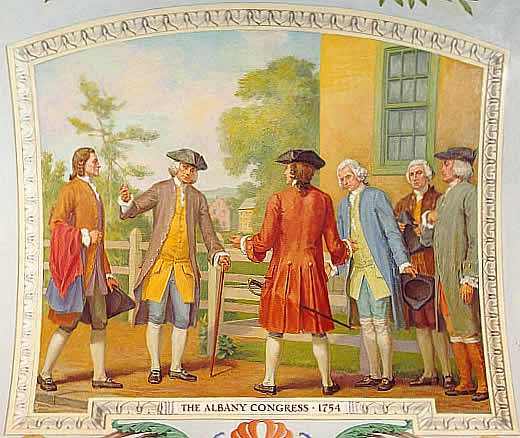
The Albany Congress of 1754 was a conference attended by seven colonies, which presaged later efforts at cooperation. The Stamp Act Congress of 1765 included representatives from nine colonies.
The First Continental Congress met briefly in Philadelphia, Pennsylvania in 1774, consisting of 56 delegates from all thirteen American colonies except Georgia. Among them was George Washington, who would soon be drawn out of military retirement to command the Continental Army during the American Revolutionary War. Also in attendance were Patrick Henry and John Adams, who, like all delegates, were elected by their respective colonial assemblies. Other delegates included Samuel Adams from Massachusetts, John Dickinson from Pennsylvania and New York's John Jay. This congress, in addition to formulating appeals to the British crown, established the Continental Association to administer boycott actions against Britain.
When the Second Continental Congress convened on May 10, 1775, it essentially reconstituted the First Congress. Many of the same 56 delegates who attended the first meeting participated in the second.[15] New arrivals included Benjamin Franklin and Robert Morris of Pennsylvania, John Hancock of Massachusetts, John Witherspoon of New Jersey, and Charles Carroll of Carrollton of Maryland, who was named as a late delegate due to his being Roman Catholic. Hancock was elected Congress president two weeks into the session when Peyton Randolph was recalled to Virginia to preside over the House of Burgesses. Thomas Jefferson replaced Randolph in the Virginia congressional delegation.[16] The second Congress adopted the Declaration of Independence. Witherspoon was the only active clergyman to sign the Declaration. He also signed theArticles of Confederation and attended the New Jersey (1787) convention that ratified the Federal Constitution.[17]
The newly founded country of the United States had to create a new government to replace the British Parliament. The U.S. adopted the Articles of Confederation, a declaration that established a national government with a one-house legislature. Its ratification by all thirteen colonies gave the second Congress a new name: the Congress of the Confederation, which met from 1781 to 1789.[18] The Constitutional Convention took place during the summer of 1787, in Philadelphia.[19] Although the Convention was called to revise the Articles of Confederation, the intention from the outset for some including James Madison and Alexander Hamilton was to create a new frame of government rather than amending the existing one. The delegates elected George Washington to preside over the Convention. The result of the Convention was the United States Constitution and the replacement of the Continental Congress with the United States Congress.
Social background and commonalities

Scene at the Signing of the Constitution of the United States, by Howard Chandler Christy (1940)

George Washington served as president of the 1787 Constitutional Convention.
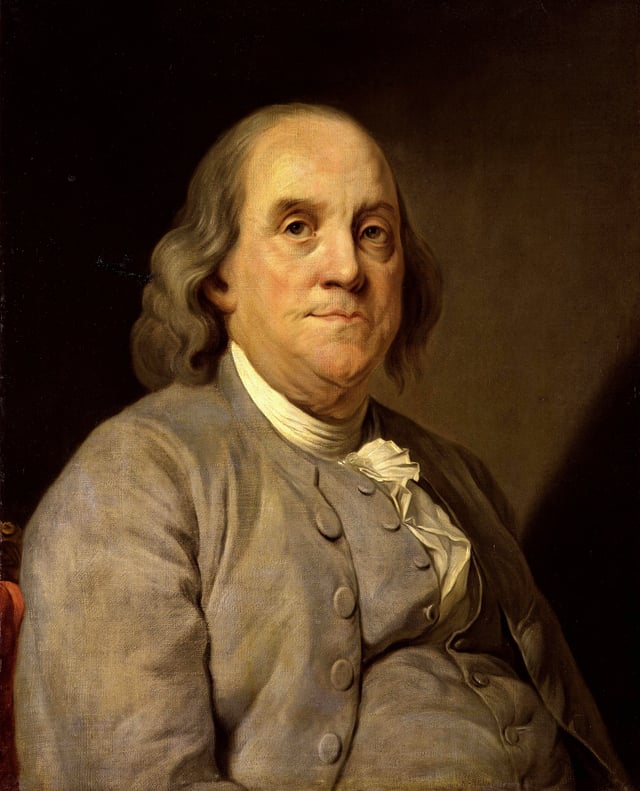
Benjamin Franklin, an early advocate of colonial unity, was a foundational figure in defining the U.S. ethos and exemplified the emerging nation's ideals.
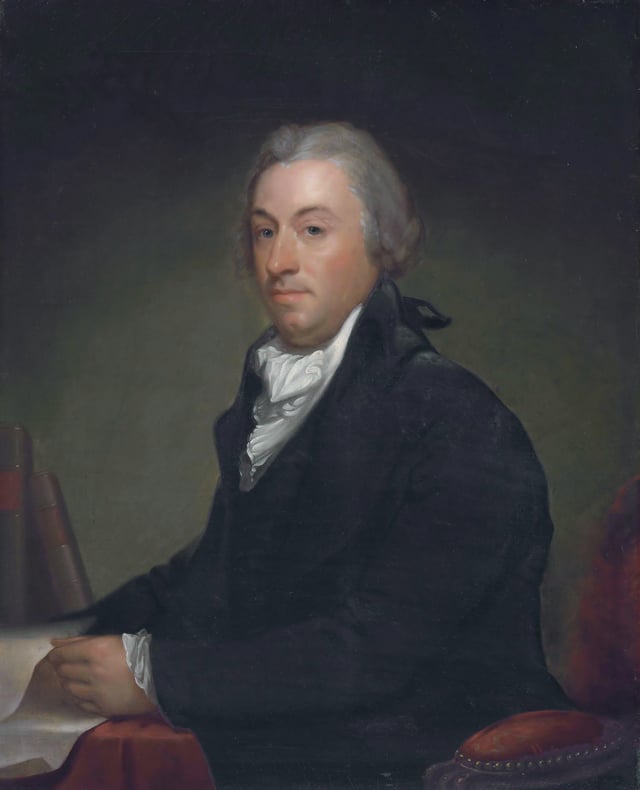
Robert R. Livingston, member of the Committee of Five that drafted the Declaration of Independence.
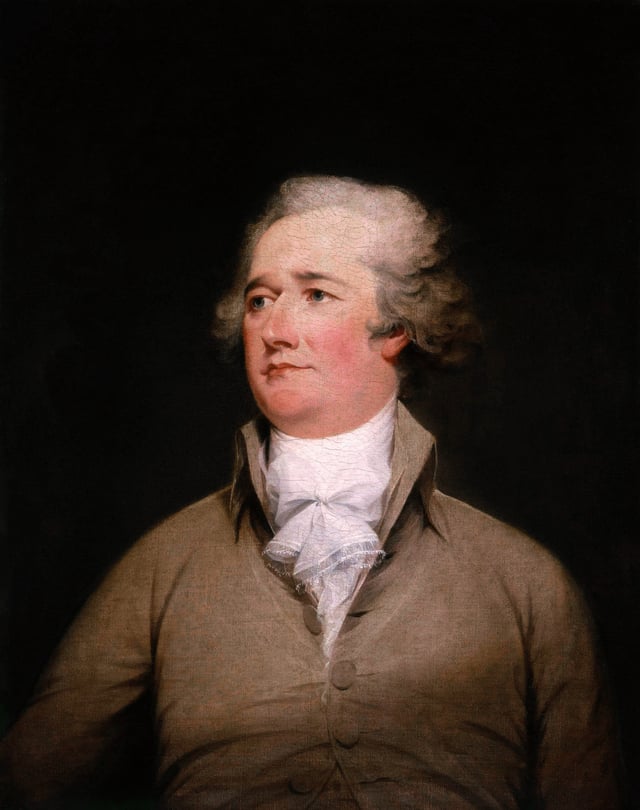
Alexander Hamilton wrote the Federalist Papers with Jay and Madison.
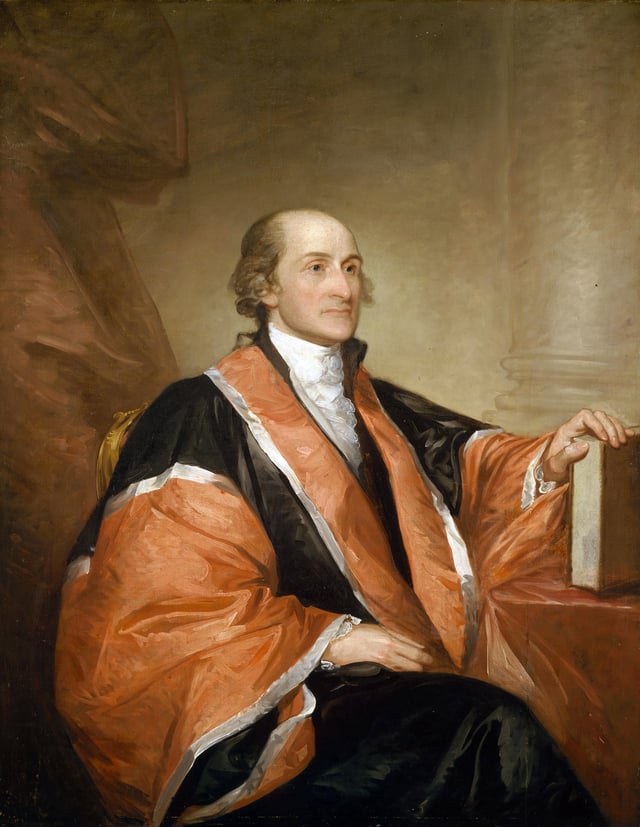
John Jay was president of the Continental Congress from 1778 to 1779 and negotiated the Treaty of Paris with Adams and Franklin.
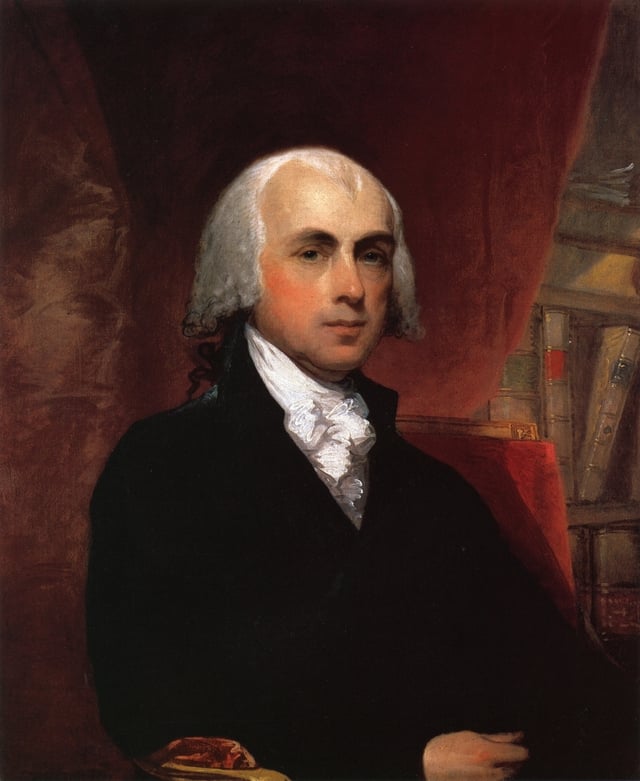
James Madison, called the "Father of the Constitution" by his contemporaries
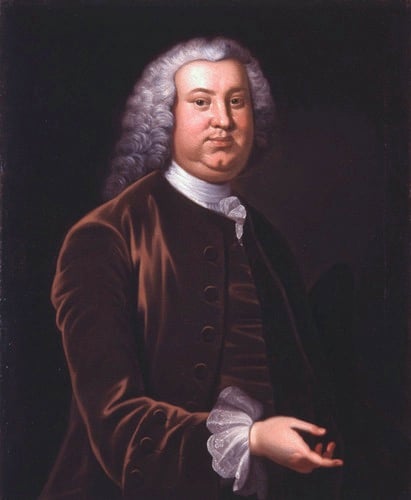
Peyton Randolph, as president of the Continental Congress, presided over creation of the Continental Association.

Richard Henry Lee, who introduced the Lee Resolution in the Second Continental Congress calling for the colonies' independence from Great Britain

John Hancock, president of the Continental Congress, renowned for his large and stylish signature on the United States Declaration of Independence
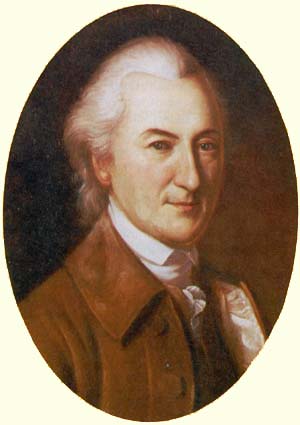
John Dickinson authored the first draft of the Articles of Confederation in 1776 while serving in the Continental Congress as a delegate from Pennsylvania, and signed them late the following year, after being elected to Congress as a delegate from Delaware.
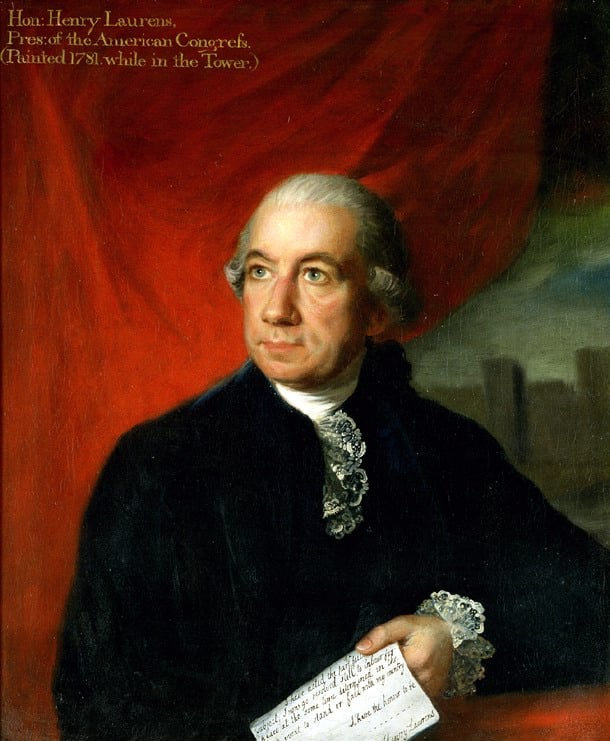
Henry Laurens was president of the Continental Congress when the Articles were passed on November 15, 1777.
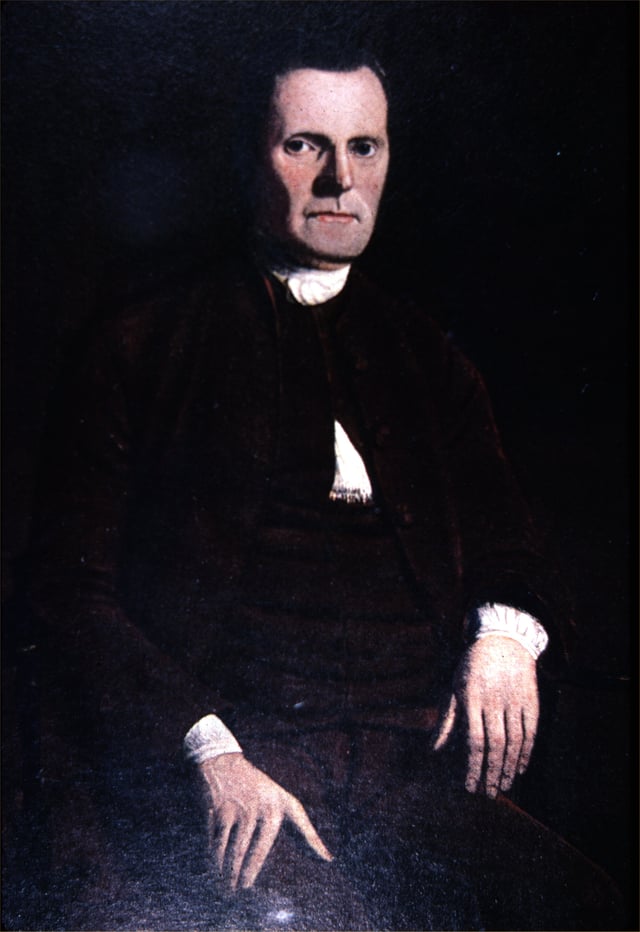
Roger Sherman, a member of the Committee of Five, the only person who signed all four U.S. historical documents

Robert Morris, president of Pennsylvania's Committee of Safety and one of the founders of the financial system of the United States.
.
The Founding Fathers represented a cross-section of 18th-century U.S. leadership. According to a study of the biographies by Caroline Robbins:
The Signers came for the most part from an educated elite, were residents of older settlements, and belonged with a few exceptions to a moderately well-to-do class representing only a fraction of the population. Native or born overseas, they were of British stock and of the Protestant faith.[20][21]
They were leaders in their communities; several were also prominent in national affairs. Virtually all participated in the American Revolution; at the Constitutional Convention at least 29 had served in the Continental Army, most of them in positions of command. Scholars have examined the collective biography of the Founders, including both the signers of the Declaration and of the Constitution.[22]
Education
Many of the Founding Fathers attended or graduated from the colonial colleges, most notably Columbia known at the time as "King's College", Princeton originally known as "The College of New Jersey", Harvard College, the College of William and Mary, Yale College and University of Pennsylvania. Some had previously been home schooled or obtained early instruction from private tutors or academies.[23] Others had studied abroad. Ironically, Benjamin Franklin who had little formal education himself would ultimately establish the College of Philadelphia based on European models (1740); "Penn" would have the first medical school (1765) in the thirteen colonies where another Founder, Benjamin Rush would eventually teach.
With a limited number of professional schools established in the U.S., Founders also sought advanced degrees from traditional institutions in England and Scotland such as the University of Edinburgh, the University of St. Andrews, and the University of Glasgow.
Colleges attended
College of William and Mary: Thomas Jefferson, Benjamin Harrison V[24]
Harvard College: John Adams, Samuel Adams, John Hancock and William Williams
King's College (now Columbia): John Jay, Alexander Hamilton, Gouverneur Morris, Robert R. Livingston and Egbert Benson.[25]
College of New Jersey (now Princeton): James Madison, Gunning Bedford Jr., Aaron Burr, Benjamin Rush and William Paterson
College of Philadelphia later merged into the University of Pennsylvania: Hugh Williamson
Yale College: Oliver Wolcott
James Wilson attended the University of St. Andrews, the University of Glasgow,[26] and the University of Edinburgh though he never received a degree.
Advanced degrees and apprenticeships
Doctors of Medicine
University of Edinburgh: Rush [27]
University of Utrecht, Netherlands: Williamson
Theology
University of Edinburgh: Witherspoon (attended, no degree)
University of St. Andrews: Witherspoon (honorary doctorate)
Legal apprenticeships
Several like John Jay, James Wilson, John Williams and George Wythe[28] were trained as lawyers through apprenticeships in the colonies while a few trained at the Inns of Court in London. Charles Carroll of Carrollton earned his law degree at Temple in London.
Self-taught or little formal education
Franklin, Washington, John Williams and Henry Wisner had little formal education and were largely self-taught or learned through apprenticeship.
Demographics
The great majority were born in the Thirteen Colonies. But at least nine were born in other parts of the British Empire:
England: Robert Morris, Button Gwinnett
Ireland: Butler, Fitzsimons, McHenry and Paterson
West Indies: Hamilton
Scotland: Wilson and Witherspoon
Many of them had moved from one colony to another. Eighteen had already lived, studied or worked in more than one colony: Baldwin, Bassett, Bedford, Davie, Dickinson, Few, Franklin, Ingersoll, Hamilton, Livingston, Alexander Martin, Luther Martin, Mercer, Gouverneur Morris, Robert Morris, Read, Sherman, and Williamson.
Several others had studied or traveled abroad.
Occupations
The Founding Fathers practiced a wide range of high and middle-status occupations, and many pursued more than one career simultaneously. They did not differ dramatically from the Loyalists, except they were generally younger and less senior in their professions.[29]
As many as thirty-five including Adams, Hamilton, Jefferson, Madison, and Jay were trained as lawyers though not all of them practiced law. Some had also been local judges.[30]
Washington trained as a land surveyor before he became commander of a small militia.
At the time of the convention, 13 men were merchants: Blount, Broom, Clymer, Dayton, Fitzsimons, Shields, Gilman, Gorham, Langdon, Robert Morris, Pierce, Sherman and Wilson.
Broom and Few were small farmers.
Three had retired from active economic endeavors: Franklin, McHenry and Mifflin.
Franklin and Williamson were scientists, in addition to their other activities.
McClurg, McHenry, Rush and Williamson were physicians.
Johnson and Witherspoon were college presidents.
Finances
Historian Caroline Robbins in 1977 examined the status of the Signers of the Declaration of Independence and concluded: {{quote|There were indeed disparities of wealth, earned or inherited: some Signers were rich, others had about enough to enable them to attend Congress. ... The majority of revolutionaries were from moderately well-to-do or average income brackets. Twice as many Loyalists belonged to the wealthiest echelon. But some Signers were rich; few, indigent. ... The Signers were elected not for wealth or rank so much as because of the evidence they had already evinced of willingness for public service.[31] A few of them were wealthy or had financial resources that ranged from good to excellent, but there are other founders who were less than wealthy. On the whole they were less wealthy than the Loyalists.[29]
Seven were major land speculators: Blount, Dayton, Fitzsimmons, Gorham, Robert Morris, Washington, and Wilson.
Eleven speculated in securities on a large scale: Bedford, Blair, Clymer, Dayton, Fitzsimons, Franklin, King, Langdon, Robert Morris, Charles Cotesworth Pinckney, and Sherman.
Many derived income from plantations or large farms which they owned or managed, which relied upon the labor of enslaved men and women particularly in the southern colonies: Bassett, Blair, Blount, Davie,[32] Johnson, Butler, Carroll, Jefferson, Jenifer, Madison, Mason, Charles Pinckney, Charles Cotesworth Pinckney, Rutledge, Spaight, and Washington.
Eight of the men received a substantial part of their income from public office: Baldwin, Blair, Brearly, Gilman, Livingston, Madison, and Rutledge.
Prior political experience
Several of the Founding Fathers had extensive national, state, local and foreign political experience prior to the adoption of the Constitution in 1787. Some had been diplomats. Several had been members of the Continental Congress or elected president of that body.
Benjamin Franklin began his political career as a city councilman and then Justice of the Peace in Philadelphia. He was next elected to the Pennsylvania Assembly and was sent by them to London as a colonial agent which helped hone his diplomatic skills.
Jefferson, Adams, Jay and Franklin all acquired significant political experience as ministers to countries in Europe.
John Adams and John Jay drafted the Constitutions of their respective states, Massachusetts and New York, and successfully navigated them through to adoption.
Jay, Thomas Mifflin and Nathaniel Gorham had served as president of the Continental Congress.
Gouverneur Morris had been a member of the New York Provincial Congress.
John Dickinson, Franklin, Langdon, and Rutledge had been governors or presidents of their states.
Robert Morris had been a member of the Pennsylvania Assembly and president of Pennsylvania's Committee of Safety (American Revolution). He was also a member of the Committee of Secret Correspondence.
Roger Sherman had served in the Connecticut House of Representatives.
Elbridge Gerry was a member of the Massachusetts Provincial Congress.
Carroll served in the Maryland Senate.
Wythe's first exposure to politics was as a member of Virginia's House of Burgesses.
Read's entry into the political arena was as a commissioner of the town of Charlestown, Maryland.
Clymer was a member of the Philadelphia Committee of Safety and the Continental Congress.
Wilson's time as a member of the Continental Congress in 1776 was his introduction to colonial politics.
Nearly all of the 55 Constitutional Convention delegates had some experience in colonial and state government, and the majority had held county and local offices.[33] Those who lacked national congressional experience were Bassett, Blair, Brearly, Broom, Davie, Dayton, Alexander Martin, Luther Martin, Mason, McClurg, Paterson, Charles Pinckney, Strong, and Yates.
Religion
Franklin T. Lambert (2003) has examined the religious affiliations and beliefs of some of the Founders. Of the 55 delegates to the 1787 Constitutional Convention, 28 were Anglicans (i.e. Church of England; or Episcopalian, after the American Revolutionary War was won), 21 were other Protestants, and two were Roman Catholics (D. Carroll, and Fitzsimons).[34] Among the Protestant delegates to the Constitutional Convention, eight were Presbyterians, seven were Congregationalists, two were Lutherans, two were Dutch Reformed, and two were Methodists.[34]
Historian Gregg L. Frazer argues that the leading Founders (John Adams, Jefferson, Franklin, Wilson, Morris, Madison, Hamilton, and Washington) were neither Christians nor Deists, but rather supporters of a hybrid "theistic rationalism".[39]
Many Founders deliberately avoided public discussion of their faith. Historian David L. Holmes uses evidence gleaned from letters, government documents, and second-hand accounts to identify their religious beliefs.[40]
Ownership of slaves and position on slavery

Portrait of George Washington and his valet slave William Lee
The founding fathers were not unified on the issue of slavery. In her study of Thomas Jefferson, historian Annette Gordon-Reed discusses this topic, "Others of the founders held slaves, but no other founder drafted the charter for freedom".[41] In addition to Jefferson, George Washington, John Jay and many other of the Founding Fathers practiced slavery but were also conflicted by the institution which many saw as immoral and politically divisive.[42] Conversely, many founders such as Samuel Adams and John Adams were against slavery their entire lives. Benjamin Rush wrote a pamphlet in 1773 which harshly condemned slavery and beseeched the colonists to petition the king and put an end to the British African Company of Merchants which kept slavery and the slave trade going. The Continental Association of 1774 contains a clause[43] severely limiting the slave trade as part of the general boycott of British trade.[44][45][46]
Franklin, though he was a key founder of the Pennsylvania Abolition Society,[47] originally owned slaves whom he later manumitted. While serving in the Rhode Island Assembly, Stephen Hopkins introduced one of the earliest anti-slavery laws in the colonies, and John Jay would try unsuccessfully to abolish slavery as early as 1777 in the State of New York.[48] He nonetheless founded the New York Manumission Society in 1785, for which Hamilton became an officer. They and other members of the Society founded the African Free School in New York City, to educate the children of free blacks and slaves. When Jay was governor of New York in 1798, he helped secure and signed into law an abolition law; fully ending forced labor as of 1827. He freed his own slaves in 1798. Alexander Hamilton opposed slavery, as his experiences in life left him very familiar with slavery and its effect on slaves and on slaveholders,[49] although he did negotiate slave transactions for his wife's family, the Schuylers.[50] John Adams, Samuel Adams, and Thomas Paine never owned slaves.[51]
Slaves and slavery are mentioned only indirectly in the 1787 Constitution. For example, Article 1, Section 2, Clause 3 prescribes that "three fifths of all other Persons" are to be counted for the apportionment of seats in the House of Representatives and direct taxes. Additionally, in Article 4, Section 2, Clause 3, slaves are referred to as "persons held in service or labor".[47][52] The Founding Fathers, however, did make important efforts to contain slavery. Many Northern states had adopted legislation to end or significantly reduce slavery during and after the American Revolution.[52] In 1782 Virginia passed a manumission law that allowed slave owners to free their slaves by will or deed.[53] As a result, thousands of slaves were manumitted in Virginia.[53] Thomas Jefferson, in 1784, proposed to ban slavery in all the Western Territories, which failed to pass Congress by one vote.[52] Partially following Jefferson's plan, Congress did ban slavery in the Northwest Ordinance of 1787, for lands north of the Ohio River.[52]
The international slave trade was banned in all states except South Carolina, by 1800. Finally in 1807, President Jefferson called for and signed into law a Federally-enforced ban on the international slave trade throughout the U.S. and its territories. It became a federal crime to import or export a slave.[52] However, the domestic slave trade was allowed, for expansion, or for diffusion of slavery into the Louisiana Territory.[52]
Attendance at conventions
In the winter and spring of 1786–1787, twelve of the thirteen states chose a total of 74 delegates to attend the Constitutional Convention in Philadelphia. Nineteen delegates chose not to accept election or attend the debates. Among them was Patrick Henry of Virginia, who in response to questions about his refusal to attend was quick to reply, "I smelled a rat." He believed that the frame of government convention organizers were intent on building would trample upon the rights of citizens.[54] Also, Rhode Island's lack of representation at the convention was due to leader's suspicions of the convention delegates' motivations. As the colony was founded by Roger Williams as a sanctuary for Baptists, Rhode Island's absence at the Convention in part explains the absence of Baptist affiliation among those who did attend. Of the 55 who did attend at some point, no more than 38 delegates showed up at one time.[55]
Spouses and children
Only four (Baldwin, Gilman, Jenifer, and Alexander Martin) were lifelong bachelors. Many of their spouses, like Eliza Schuyler Hamilton, Martha Washington, Abigail Adams, Sarah Livingston Jay, Dolley Madison, Mary White Morris and Catherine Alexander Duer were strong women who made significant contributions of their own to the fight for liberty.[56]
Sherman fathered the largest family: 15 children by two wives. At least nine (Bassett, Brearly, Johnson, Mason, Paterson, Charles Cotesworth Pinckney, Sherman, Wilson, and Wythe) married more than once. George Washington, "The Father of our Country",[57] had no biological descendants.
Signatories to founding documents
Among the state documents promulgated between 1774 and 1789 by the Continental Congress, four are paramount: the Continental Association, the Declaration of Independence, the Articles of Confederation and the Constitution. Altogether, 145 men signed at least one of the four documents. In each instance, roughly 50% of the names signed are unique to that document. Only a few people (6) signed three of the four, and only Roger Sherman of Connecticut signed all of them.[58] The following persons signed one or more of these formative documents:
| Name | Province/state | DS | CA(1774) | DI(1776) | AC(1777) | USC(1787) |
|---|---|---|---|---|---|---|
| Andrew Adams | Connecticut | 1 | Yes | |||
| John Adams | Massachusetts | 2 | Yes | Yes | ||
| Samuel Adams | Massachusetts | 3 | Yes | Yes | Yes | |
| Thomas Adams | Virginia | 1 | Yes | |||
| John Alsop | New York | 1 | Yes | |||
| Abraham Baldwin | Georgia | 1 | Yes | |||
| John Banister | Virginia | 1 | Yes | |||
| Josiah Bartlett | New Hampshire | 2 | Yes | Yes | ||
| Richard Bassett | Delaware | 1 | Yes | |||
| Gunning Bedford Jr. | Delaware | 1 | Yes | |||
| Edward Biddle | Pennsylvania | 1 | Yes | |||
| John Blair | Virginia | 1 | Yes | |||
| Richard Bland | Virginia | 1 | Yes | |||
| William Blount | North Carolina | 1 | Yes | |||
| Simon Boerum | New York | 1 | Yes | |||
| Carter Braxton | Virginia | 1 | Yes | |||
| David Brearley | New Jersey | 1 | Yes | |||
| Jacob Broom | Delaware | 1 | Yes | |||
| Pierce Butler | South Carolina | 1 | Yes | |||
| Charles Carroll of Carrollton | Maryland | 1 | Yes | |||
| Daniel Carroll | Maryland | 2 | Yes | Yes | ||
| Richard Caswell | North Carolina | 1 | Yes | |||
| Samuel Chase | Maryland | 2 | Yes | Yes | ||
| Abraham Clark | New Jersey | 1 | Yes | |||
| William Clingan | Pennsylvania | 1 | Yes | |||
| George Clymer | Pennsylvania | 2 | Yes | Yes | ||
| John Collins | Rhode Island | 1 | Yes | |||
| Stephen Crane | New Jersey | 1 | Yes | |||
| Thomas Cushing | Massachusetts | 1 | Yes | |||
| Francis Dana | Massachusetts | 1 | Yes | |||
| Jonathan Dayton | New Jersey | 1 | Yes | |||
| Silas Deane | Connecticut | 1 | Yes | |||
| John De Hart | New Jersey | 1 | Yes | |||
| John Dickinson | Delaware | 3[1] | Yes | Yes | ||
| Pennsylvania | Yes | |||||
| William Henry Drayton | South Carolina | 1 | Yes | |||
| James Duane | New York | 2 | Yes | Yes | ||
| William Duer | New York | 1 | Yes | |||
| Eliphalet Dyer | Connecticut | 1 | Yes | |||
| William Ellery | Rhode Island | 2 | Yes | Yes | ||
| William Few | Georgia | 1 | Yes | |||
| Thomas Fitzsimons | Pennsylvania | 1 | Yes | |||
| William Floyd | New York | 2 | Yes | Yes | ||
| Nathaniel Folsom | New Hampshire | 1 | Yes | |||
| Benjamin Franklin | Pennsylvania | 2 | Yes | Yes | ||
| Christopher Gadsden | South Carolina | 1 | Yes | |||
| Joseph Galloway | Pennsylvania | 1 | Yes | |||
| Elbridge Gerry | Massachusetts | 2 | Yes | Yes | ||
| Nicholas Gilman | New Hampshire | 1 | Yes | |||
| Nathaniel Gorham | Massachusetts | 1 | Yes | |||
| Button Gwinnett | Georgia | 1 | Yes | |||
| Lyman Hall | Georgia | 1 | Yes | |||
| Alexander Hamilton | New York | 1 | Yes | |||
| John Hancock | Massachusetts | 2 | Yes | Yes | ||
| John Hanson | Maryland | 1 | Yes | |||
| Cornelius Harnett | North Carolina | 1 | Yes | |||
| Benjamin Harrison | Virginia | 2 | Yes | Yes | ||
| John Hart | New Jersey | 2 | Yes | |||
| John Harvie | Virginia | 1 | Yes | |||
| Patrick Henry | Virginia | 1 | Yes | |||
| Joseph Hewes | North Carolina | 2 | Yes | Yes | ||
| Thomas Heyward Jr. | South Carolina | 2 | Yes | Yes | ||
| Samuel Holten | Massachusetts | 1 | Yes | |||
| William Hooper | North Carolina | 2 | Yes | Yes | ||
| Stephen Hopkins | Rhode Island | 2 | Yes | Yes | ||
| Francis Hopkinson | New Jersey | 1 | Yes | |||
| Titus Hosmer | Connecticut | 1 | Yes | |||
| Charles Humphreys | Pennsylvania | 1 | Yes | |||
| Samuel Huntington | Connecticut | 2 | Yes | Yes | ||
| Richard Hutson | South Carolina | 1 | Yes | |||
| Jared Ingersoll | Pennsylvania | 1 | Yes | |||
| William Jackson | South Carolina | 1 | Yes | |||
| John Jay | New York | 1 | Yes | |||
| Thomas Jefferson | Virginia | 1 | Yes | |||
| Daniel of St. Thomas Jenifer | Maryland | 1 | Yes | |||
| Thomas Johnson | Maryland | 1 | Yes | |||
| William Samuel Johnson | Connecticut | 1 | Yes | |||
| Rufus King | Massachusetts | 1 | Yes | |||
| James Kinsey | New Jersey | 1 | Yes | |||
| John Langdon | New Hampshire | 1 | Yes | |||
| Edward Langworthy | Georgia | 1 | Yes | |||
| Henry Laurens | South Carolina | 1 | Yes | |||
| Francis Lightfoot Lee | Virginia | 2 | Yes | Yes | ||
| Richard Henry Lee | Virginia | 3 | Yes | Yes | Yes | |
| Francis Lewis | New York | 2 | Yes | Yes | ||
| Philip Livingston | New York | 2 | Yes | Yes | ||
| William Livingston | New Jersey | 2 | Yes | Yes | ||
| James Lovell | Massachusetts | 1 | Yes | |||
| Isaac Low | New York | 1 | Yes | |||
| Thomas Lynch | South Carolina | 1 | Yes | |||
| Thomas Lynch Jr. | South Carolina | 1 | Yes | |||
| James Madison | Virginia | 1 | Yes | |||
| Henry Marchant | Rhode Island | 1 | Yes | |||
| John Mathews | South Carolina | 1 | Yes | |||
| James McHenry | Maryland | 1 | Yes | |||
| Thomas McKean | Delaware | 3 | Yes | Yes | Yes | |
| Arthur Middleton | South Carolina | 1 | Yes | |||
| Henry Middleton | South Carolina | 1 | Yes | |||
| Thomas Mifflin | Pennsylvania | 2 | Yes | Yes | ||
| Gouverneur Morris | New York | 2[2] | Yes | |||
| Pennsylvania | Yes | |||||
| Lewis Morris | New York | 1 | Yes | |||
| Robert Morris | Pennsylvania | 3 | Yes | Yes | Yes | |
| John Morton | Pennsylvania | 2 | Yes | Yes | ||
| Thomas Nelson Jr. | Virginia | 1 | Yes | |||
| William Paca | Maryland | 2 | Yes | Yes | ||
| Robert Treat Paine | Massachusetts | 2 | Yes | Yes | ||
| William Paterson | New Jersey | 1 | Yes | |||
| Edmund Pendleton | Virginia | 1 | Yes | |||
| John Penn | North Carolina | 2 | Yes | Yes | ||
| Charles Pinckney | South Carolina | 1 | Yes | |||
| Charles Cotesworth Pinckney | South Carolina | 1 | Yes | |||
| Peyton Randolph | Virginia | 1 | Yes | |||
| George Read | Delaware | 3 | Yes | Yes | Yes | |
| Joseph Reed | Pennsylvania | 1 | Yes | |||
| Daniel Roberdeau | Pennsylvania | 1 | Yes | |||
| Caesar Rodney | Delaware | 2 | Yes | Yes | ||
| George Ross | Pennsylvania | 2 | Yes | Yes | ||
| Benjamin Rush | Pennsylvania | 1 | Yes | |||
| Edward Rutledge | South Carolina | 2 | Yes | Yes | ||
| John Rutledge | South Carolina | 2 | Yes | Yes | ||
| Nathaniel Scudder | New Jersey | 1 | Yes | |||
| Roger Sherman | Connecticut | 4 | Yes | Yes | Yes | Yes |
| James Smith | Pennsylvania | 1 | Yes | |||
| Jonathan Bayard Smith | Pennsylvania | 1 | Yes | |||
| Richard Smith | New Jersey | 1 | Yes | |||
| Richard Dobbs Spaight | North Carolina | 1 | Yes | |||
| Richard Stockton | New Jersey | 1 | Yes | |||
| Thomas Stone | Maryland | 1 | Yes | |||
| John Sullivan | New Hampshire | 1 | Yes | |||
| George Taylor | Pennsylvania | 1 | Yes | |||
| Edward Telfair | Georgia | 1 | Yes | |||
| Matthew Thornton | New Hampshire | 1 | Yes | |||
| Matthew Tilghman | Maryland | 1 | Yes | |||
| Nicholas Van Dyke | Delaware | 1 | Yes | |||
| George Walton | Georgia | 1 | Yes | |||
| John Walton | Georgia | 1 | Yes | |||
| Samuel Ward | Rhode Island | 1 | Yes | |||
| George Washington | Virginia | 2 | Yes | Yes | ||
| John Wentworth Jr. | New Hampshire | 1 | Yes | |||
| William Whipple | New Hampshire | 1 | Yes | |||
| John Williams | North Carolina | 1 | Yes | |||
| William Williams | Connecticut | 1 | Yes | |||
| Hugh Williamson | North Carolina | 1 | Yes | |||
| James Wilson | Pennsylvania | 2 | Yes | Yes | ||
| Henry Wisner | New York | 1 | Yes | |||
| John Witherspoon | New Jersey | 2 | Yes | Yes | ||
| Oliver Wolcott | Connecticut | 2 | Yes | Yes | ||
| George Wythe | Virginia | 1 | Yes |
Notes:
Post-constitution life
Subsequent events in the lives of the Founding Fathers after the adoption of the Constitution were characterized by success or failure, reflecting the abilities of these men as well as the vagaries of fate.[59] Washington, Adams, Jefferson, Madison, and Monroe served in highest U.S. office of president. Jay would be appointed as president of the United States and later elected to two terms as Governor of New York.
Seven (Fitzsimons, Gorham, Luther Martin, Mifflin, Robert Morris, Pierce, and Wilson) suffered serious financial reversals that left them in or near bankruptcy. Robert Morris spent three of the last years of his life imprisoned following bad land deals.[56] Two, Blount and Dayton, were involved in possibly treasonous activities. Yet, as they had done before the convention, most of the group continued to render public service, particularly to the new government they had helped to create.
Youth and longevity

Death age of the Founding Fathers
Many of the Founding Fathers were under 40 years old at the time of the signing of the Declaration of Independence in 1776: Alexander Hamilton was 19, Aaron Burr was 20, Gouverneur Morris was 24. The oldest were Benjamin Franklin, 70, and Samuel Whittemore, 81.[60]
A few Founding Fathers lived into their nineties, including: Paine Wingate, who died at age 98; Charles Carroll of Carrollton, who died at age 95; Charles Thomson, who died at 94; William Samuel Johnson, who died at 92; and John Adams, who died at 90. Among those who lived into their eighties were Benjamin Franklin, Samuel Whittmore, John Jay, Thomas Jefferson, James Madison, John Armstrong Jr., Hugh Williamson, and George Wythe. Approximately 16 died while in their seventies, and 21 in their sixties. Three (Alexander Hamilton, Richard Dobbs Spaight, and Button Gwinnett) were killed in duels. Two, John Adams and Thomas Jefferson, died on the same day, July 4, 1826.[61]
The last remaining founders, also poetically called the "Last of the Romans", lived well into the nineteenth century.[62] The last surviving signer of the Declaration of Independence was Charles Carroll of Carrollton, who died in 1832.[63] The last surviving member of the Continental Congress was John Armstrong Jr., who died in 1843. He gained this distinction in 1838 upon the death of the only other surviving delegate, Paine Wingate.[64]
Other notable people of the period
The following men and women who had little or nothing to do with actually setting up the American federal government are occasionally called "founders" of the United States by some 21st-century writers:
Abigail Adams, advisor, First Lady and mother of a president[65]
Ethan Allen, military and political leader in Vermont[66]
Richard Allen, African-American bishop[67]
John Bartram, botanist, horticulturist and explorer[68]
Egbert Benson, politician from New York[69]
Elias Boudinot, New Jersey delegate to Continental Congress[70]
Aaron Burr, Vice President under Jefferson[71]
George Rogers Clark, army general[72]
George Clinton, New York governor and Vice President of the U.S.[73]
Tench Coxe, economist in the Continental Congress[74]
William Richardson Davie, delegate to the Constitutional Convention (leaving before he could sign it), and Governor of North Carolina
Albert Gallatin, politician and Treasury Secretary[75]
Horatio Gates, army general[72]
Nathanael Greene, army general[72]
Nathan Hale, captured U.S. soldier executed in 1776[65]
Elizabeth Schuyler Hamilton, wife of Alexander Hamilton[76][77]
Esek Hopkins, Commander-in-Chief of the Continental Navy
James Iredell, advocate for Constitution, judge[73]
John Paul Jones, navy captain[72]
Henry Knox, army general, Secretary of War[73]
Tadeusz Kościuszko, Polish army general[75]
Gilbert du Motier, Marquis de Lafayette, French army general[75]
John Laurance, New York politician and judge who served as Judge Advocate General during the Revolution.[78]
Henry Lee III, army officer and Virginia governor[72]
Robert R. Livingston, diplomat and jurist[65]
William Maclay, Pennsylvania politician and U.S. Senator[73]
Dolley Madison, spouse of President James Madison[65]
John Marshall, fourth Chief Justice of the United States[65]
George Mason, revolutionary writer, co-father of the Bill of Rights[79]
Philip Mazzei, Italian physician, merchant and author[80]
James Monroe, fifth President of the United States[81]
Daniel Morgan, military hero and Virginia Congressman[72]
Samuel Nicholas, Commander-in-Chief of the Continental Marines
James Otis Jr., Massachusetts lawyer and politician[82]
Andrew Pickens, army general and South Carolina congressman[72]
Timothy Pickering, U.S. Secretary of State from Massachusetts[85]
Israel Putnam, army general[86]
Edmund Randolph, first United States Attorney General, second Secretary of State[87]
Jean-Baptiste Donatien de Vimeur, comte de Rochambeau, French army general[75]
Haym Solomon, financier and spy for Continental Army[88]
Thomas Sumter, South Carolina military hero and member of both houses of Congress[72]
Joseph Warren, doctor, revolutionary leader[86]
Mercy Otis Warren, political writer[73]
Anthony Wayne, army general and politician[72]
Noah Webster, writer, lexicographer, educator[89]
Thomas Willing, banker[90]
Legacy
Institutions formed by Founders
Several Founding Fathers were instrumental in establishing schools and societal institutions that still exist today:
Franklin founded the University of Pennsylvania, while Jefferson founded the University of Virginia.
Rush founded Dickinson College and Franklin College, (today Franklin and Marshall) as well as the College of Physicians of Philadelphia, the oldest medical society in America.
Hamilton founded the New York Post, as well as the United States Coast Guard.
Knox[91] helped found the Society of the Cincinnati in 1783; the society was predicated on service as an officer in the Revolutionary War and heredity. Members included Washington, Hamilton and Burr. Other Founders like Sam Adams, John Adams, Franklin and Jay criticized the formation of what they considered to be an elitist body and threat to the Constitution. Franklin would later accept an honorary membership though Jay declined.[92]
Scholarship on the Founders
Articles and books by twenty-first century historians combined with the digitization of primary sources like handwritten letters continue to contribute to an encyclopedic body of knowledge about the Founding Fathers.
Historians who focus on the Founding Fathers
Ron Chernow won the Pulitzer Prize for his biography of George Washington. His bestselling book about Alexander Hamilton inspired the blockbuster musical of the same name.
Joseph J. Ellis – According to Ellis, the concept of the Founding Fathers of the U.S. emerged in the 1820s as the last survivors died out. Ellis says "the founders", or "the fathers", comprised an aggregate of semi-sacred figures whose particular accomplishments and singular achievements were decidedly less important than their sheer presence as a powerful but faceless symbol of past greatness. For the generation of national leaders coming of age in the 1820s and 1830s – men like Andrew Jackson, Henry Clay, Daniel Webster, and John C. Calhoun – "the founders" represented a heroic but anonymous abstraction whose long shadow fell across all followers and whose legendary accomplishments defied comparison.
We can win no laurels in a war for independence," Webster acknowledged in 1825. "Earlier and worthier hands have gathered them all. Nor are there places for us ... [as] the founders of states. Our fathers have filled them. But there remains to us a great duty of defence and preservation.[93]
Joanne B. Freeman – Freeman's area of expertise is the life and legacy of Alexander Hamilton as well as political culture of the revolutionary and early national eras.[94][95][96] Freeman has documented the often opposing visions of the Founding Fathers as they tried to build a new framework for governance, "Regional distrust, personal animosity, accusation, suspicion, implication, and denouncement—this was the tenor of national politics from the outset." [97]
Annette Gordon-Reed is an American historian and Harvard Law School professor. She is noted for changing scholarship on Thomas Jefferson regarding his relationship with Sally Hemings and her children. She has studied the challenges facing the Founding Fathers particularly as it relates to their position and actions on slavery. She points out "the central dilemma at the heart of American democracy: the desire to create a society based on liberty and equality" that yet does not extend those privileges to all."[41]
Jack N. Rakove – Thomas Jefferson
Peter S. Onuf – Thomas Jefferson
Noted collections of the Founding Fathers
Adams Papers Editorial Project
Founders Online – a searchable database of over 178,000 documents authored by or addressed to George Washington, John Jay, Benjamin Franklin, John Adams (and family), Thomas Jefferson, Alexander Hamilton and James Madison.
The Papers of Alexander Hamilton [109]
The Selected Papers of John Jay at Columbia University
The Papers of Thomas Jefferson at Princeton University
The Papers of James Madison at University of Virginia
The Washington Papers at University of Virginia
The Franklin Papers at Yale University
In stage and film
The Founding Fathers were portrayed in the Tony Award–winning musical 1776, which depicted the debates over, and eventual adoption of, the Declaration of Independence; the stage production was adapted into the 1972 film of the same name.
Several Founding Fathers—Hamilton, Washington, Jefferson, Madison, Laurens and Burr—were reimagined in Hamilton, a production inspired by the 2004 biography Alexander Hamilton, with music, lyrics and book by Lin-Manuel Miranda. The musical won eleven Tony Awards and a Pulitzer Prize for Drama.[98]
Children's books
In their 2015 children's book, The Founding Fathers author Jonah Winter and illustrator Barry Blitt categorized 14 leading patriots into two teams based on their contributions to the formation of America – the Varsity Squad (Washington, Franklin, Jefferson, John Adams, Madison, Jay, and Hamilton) and the Junior Varsity Squad (Sam Adams, Hancock, Henry, Morris, Marshall, Rush, and Paine).[99]
See also
List of national founders (worldwide)
History of the United States Constitution
Rights of Englishmen
Patriot (American Revolution)
Sons of Liberty
Military leadership in the American Revolutionary War
Father of the Nation